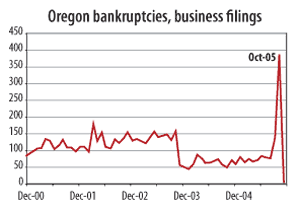
The rush of new bankruptcies last year, in advance
of stricter laws enacted by Congress that
took effect mid-October, was even greater than
anticipated. The U.S. Courts’ fiscal year, ending
September 2005, saw a record number of bankruptcies:
1,782,643. In Oregon, October year-to date
business filings were 73% greater than the
same period in 2004. For nonbusiness filings, the
difference was 65%. In November, after the new
laws were in place, filings slowed to a trickle.
Oregon seems to have a larger share of bankruptcies
than neighboring states and the United States
overall. For the 12 months prior to June 2005, one
out of every 144 Oregonians filed for bankruptcy,
compared to just one out of 167 Washingtonians
and one out of 181 U.S. citizens.

Trade steps up
Strong housing markets deserve much of the credit for the recent strength of the Pacific
Northwest economy. But don’t overlook the importance of growing international trade.
New state-level data on 2005 merchandise exports show the Pacific Northwest on pace
to break by a wide margin 1999’s record of $52.4 billion in exports.
Washington exports are turning around due to resurgent production at Boeing.
Aircraft, because of their high value, tend to overshadow other Washington exports.
Aircraft accounted for two-thirds of Washington’s 2002 exports, 58% of 2003’s total
and 51% of 2004’s.
After aircraft, Washington’s big export categories include (among others) cereals,
electrical and industrial machinery, wood exports grew at a strong 22% in 2003
and 17% in 2004. Japan, Canada, China, Taiwan and Korea were Washington’s leading
2004 export destinations.
After a red-hot 2004 (exports were up 39%), Idaho’s export growth slowed in 2005. The top
three categories of Idaho exports in 2004 all were related to high tech: digital integrated
circuits — think Micron Technology memory chips — plus computer parts and other integrated
circuits. The United Kingdom was Idaho’s top 2004 customer, followed by Canada, Singapore,
Taiwan and Japan.
Oregon had the slowest export growth in the first three quarters of 2005. Computer
logic chips made by Intel factories in Oregon are among the state’s leading exports. Oregon
high-tech exports have yet to recover fully to the peak reached in 2000, the year of the dotcom
bubble burst. Top destinations for Oregon exports in 2004 were, in order, Canada, Japan,
Korea, China and the Philippines.
In another aspect of international trade, traffic continues to rise at the West Coast’s
principal container ports. Through October, the Port of Seattle handed 1.12 million 20-
foot equivalent containter units (or TEUs), up 29% from the corresponding 2004 stretch. At
the Port of Tacoma, TEU traffic was up 17%.
— Excerpted from Marple’s Pacific Northwest Letter, editor Michael Parks. For information on this biweekly report on Northwest economic trends, visit www.marples.com.
Diversified mix stabilizes financial activities
The financial activities sector covers a variety of industries — banking, real estate, auto
rental and others — so its subsectors vary widely in wages and employment trends. In 2004,
for example, the U.S. average annual wage in the fi nance and insurance subsector was 88%
higher than the average in real estate and leasing. So the sector’s highest wages were in the
fi nance-dominated Northeast, while the real estate boom helped a Western state, Nevada, see
the strongest job gains. In Oregon, opposing trends among subgroups have dampened both
growth and decline of fi nancial activities employment. Job growth in fi nance and insurance
slowed in mid-2003, due in part to cooling refi nance activity.
But stability in real estate and leasing moderated effects on the broad sector. In 2005, the opposite occurred as finance employment surged and real estate slowed. But jobs in real estate and leasing still account for a larger share of financial activities employment in Oregon than in the United States. This factor, among others, has kept the sector’s wages consistently below the national average.


